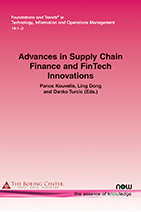Production Planning with Inventory-Based Financing
By Renato de Matta, College of Business, University of Iowa, USA, renato-dematta@uiowa.edu | Vernon Hsu, CUHK Business School, The Chinese University of Hong Kong, Hong Kong, vhsu@cuhk.edu.hk
Abstract
This paper uses a mixed integer programming model to study a production and inventory planning problem faced by a manufacturer who utilizes Inventory-Based Financing (IBF) to capture additional demands during peak seasons that otherwise will not be met due to a shortage of working capital. By exploiting the problem’s inherent structure of three distinct but related manufacturer decisions, i.e., the production, financing and working capital allocation decisions, the paper develops a branch-and-bound procedure to solve the model which is shown to be NP-hard. Through a series of numerical experiments, our study provides a number of interesting managerial insights into how the manufacturer’s optimal production and inventory plans could differ with and without IBF. Specifically, we find that (a) the manufacturer would strategically overstock his inventory for the purpose of securing more loans, and this overstocking behavior is more acute in periods immediately prior to the peak demand period; and (b) the manufacturer could take advantage of the difference in peak and non-peak seasons of product demands by partially financing the production of one product through pledging the cycle inventory of another product.
Emerging Advances in Supply Chain Finance and FinTech Innovations
Advances in Supply Chain Finance and FinTech Innovations examines three themes:
Financing Issues in Supply Chains look into popular working capital management financing practices: trade credits and guarantor practices including advanced trade credit practices in supply chains, guarantor financing practices for capital constrained retailers, and innovative practices of joint financing of capital constrained firms by a bank.
FinTech Innovations for Supply Chains examines business model innovations for supply chain financing supported through new platform technologies (such as blockchain), and simple financial technologies effectively implemented for high impact in supply chain risk management.
Advances in Risk Management of Operational Systems provide state-of-the art thinking on many risk issues in supply chain operations including disruption strategies over the product life cycle, the production planning complexities for a capital constrained manufacturer that uses Inventory Based Financing (IBF) scheme to fund its working capital needs, capacity procurement decision, capacity planning in the presence of demand and price uncertainty, and valuing complex real options in dynamic operational settings.

Companion
Foundations and Trends® in Technology, Information and Operations Management, Volume 14, Issue 1-2 Special Issue: Advances in Supply Chain Finance and FinTech Innovations
See the other articles that are also part of this special issue.